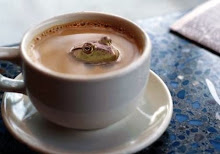
(source)
What is Tokidoki? Tokidoki translates to, "sometimes", in Japanese. Created by Italy born, Simone Legno -- Tokidoki is a brand of purses, t-shirts, hoodies, day planners, toys and other clothing and accessory items. Tokidoki products feature cute characters such as playful unicorns, funky bears, skeleton kids and more. Even random accented characters like diamonds, birds, flowers, coffee cups and rain clouds, have adorable facial expressions. Tokidoki often collaborates with Hello Kitty which makes the brand exceptionally exciting for me.
Until now, Tokidoki did not disappoint. Although, the Tokidoki Barbie comes with some key differences from the average Barbie -- it is not without the usual boatload of sexism.
(source)
This Barbie has pretty pink cotton candy hair and rockin' tattoos. I don't doubt that many will leap at the chance to purchase this "alternative" doll. As if this doll is meant for the rest of us. "The rest of us", meaning, those who can identify with the doll's hair and ink and/or those who prefer this aesthetic, to the traditional blonde haired, blue eyed, stereotype of femininity.
Offering young girls a variety is great, but there is still an essential evil that remains. This doll is just as rail thin as all the other Barbies.
(source)
The Tokidoki Barbie is meant for adults. Sort of. It's not being sold on the shelves and it is meant to be a collectors item. But how much do you want to bet that adults will be handing these dolls off to their children?
Over the years, Barbie has expanded her horizons, as allowed by Mattel. She's been tagged with various career choices, such as doctor; nurse; athlete; astronaut; airplane pilot, President and more. She has also come in a variety of ethnicities; although, every non-white Barbie only vaguely resembles the designated cultural background (Have you seen Asian Barbie? Her slanted eyes are not slanted. As if Asian women have not been bombarded enough with the false notion that it is creased eyelids that some how produce brains and beauty).
Again, I applaud variety, but the central truism remains. Barbie offers an unobtainable ideal which many, many women aspire to. Barbie was put out on the shelves in 1959. She lived the high life, with fancy clothes and decked out cars. She was a doll of privilege. She was and remains to be a doll of frightening measurement.
According to Forever Barbie: The Unauthorized Biography of a Real Doll, the University Central Hospital in Helsinki, Finland, once reported that any girl as thin as Barbie would be missing 17 - 22% body fat. Without this, a girl would be unable to menstruate. According to Change.org, in 1965, Slumber Party Barbie came with a book entitled "How to Lose Weight", which advised girls -- "Don't eat." In 1997 Barbie was given a thicker waist. I'm not sure how much thicker but I haven't noticed too much of an increase. Barbie's original measurements were 36 by 18 by 33. Yikes.
There are some who take the Barbie ideal to extremes. Plastic surgery addict and Body Dismorphic Disorder sufferer, Jenny Lee is a good example.
(source)
Lee, openly admits that she strives to look as Barbie does. According to Cosmetic Surgery Guru, by 2009 Lee had gone under the knife at least 30 times.
Reality TV star, Heidi Montag created a buzz when she announced that she underwent 10 surgeries in one fell swoop, in 2010. Montag has explained in interviews that she had no desire to come out looking like Barbie. Even so, it is difficult not to notice the resemblance.
As I said, these are extremes. And although not every girl wishes to be Barbie or actively seeks to look like her, most girls have their own idea of what an ideal body looks like. My personal experience in former roles as a foster care social worker; group home social worker, and youth shelter social worker, have exposed me to the yearnings of young girls to look like anything but themselves.
Being a friend to women with children, I have witnessed young girls beg for Barbie dolls or Barbie-like dolls. All of this brings me pain -- pain for young girls and pain for women everywhere. I am of course including myself in this lot.
In the end, the same women who have been oppressed by non-realistic standards are the same who must rebel in order to find acceptance. Women must rebel because; not doing so, means that we accept what is. What is -- is dangerous.
Tokidoki has made a marginal improvement in expanding the idea that is Barbie -- but not much.





No comments:
Post a Comment